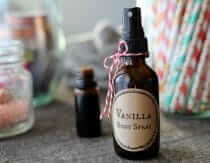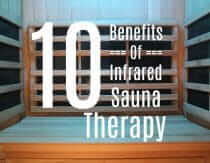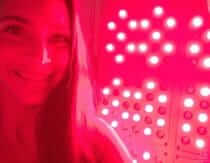
Can good vibrations really support lymphatic drainage, muscle toning, hormone production, bone mineral density and more? When I was introduced to the research behind whole body vibration therapy by a friend (who is also a doctor), I became so fascinated that I ended up getting a vibration plate to use at home.
We’ll dive into all the juicy studies soon, but first I think you’ll love the story of how modern vibration therapy got started as much as I do. Here’s how Scientific American tells it:
In the 1960s, Russian scientists embraced vibration therapy, dubbing it rhythmic neuromuscular stimulation. They believed that they had discovered a way to support not only muscle building but also a way to help stimulate bone regeneration. Then in 1995, the cosmonaut Valery Polyakov (the Ironman of Space Flight) lived in space for 438 days without losing (much) bone density thanks to WBVT. In fact, instead of being carried from the Soyuz spacecraft to a nearby chair, as is customary, Valery walked. Not too shabby for having been in zero gravity for nearly 15 months.”
Not too shabby indeed. At the time, U.S. astronauts who were not using vibration therapy could only stay in space for 196 days before returning to earth due to muscle degeneration. Polyakov, who was a doctor, still holds the record for the longest single spaceflight in history.
Of course, extreme environments like space are very different from say, our living rooms, so in this article we’ll look at what the research says (and doesn’t say) about the benefits of whole body vibration in general.
As always, none of these statements have been evaluated by the FDA, this article is not medical advice, and it is not meant to diagnose or treat any condition. Now that we’ve got that out of the way, let’s dive in.
- What is vibration plate therapy?
- Benefits of Whole Body Vibration Plate Therapy
- Strength & Endurance
- Lymphatic Flow & Detoxification
- Hormone Production & Stress Relief
- Bone Mineral Density
- Healthy Blood Flow
- Collagen Production
- Blood Sugar Support
- Who should not use a vibration plate?
- Choosing A Vibration Plate
- Which Vibration Plate I Chose (And Why)
- Products Mentioned In This Article
What is vibration plate therapy? ^
Just like the name says, vibration plate therapy involves standing on a platform (plate) that vibrates either up-and-down or side-to-side (or both). The vibration is thought to activate the circulatory, lymphatic, and nervous systems at the same time.
The multi-system effects are believed to be due to how vibration therapy increases the impact of gravity on our muscles, bone, cartilage, soft tissues, and joints. As the platform moves, it increases the gravitational force on our bodies, which prompts involuntary responses that help us maintain balance.
Every muscle fiber will automatically tense and relax at the same rate that the machine is vibrating, usually twenty to fifty times per second. That adds up to one thousand to three thousand tiny little ‘reps’ per minute – much more work for your muscles than holding a position (static or isometric exercise) or typical repetition workouts.” (1)
However, the mechanical effect on our muscles may just be part of what makes whole body vibration (WBV) unique.
One theory is that vibrational frequencies may have a “tuning” effect on our bodies, especially when the vibration matches the resonant frequency of muscle, bone, synovial fluid and other tissues.
According to Discover Magazine:
It could be that WBV is simply forcing our muscles to compensate for extra stress, making them work harder and get stronger. But some scientists have proposed that the vibrations, when administered at the correct frequency, are actually reaching into the control systems of our muscles, forcing them to activate.” (2)
Benefits of Whole Body Vibration Plate Therapy ^
Proponents of vibration therapy say that it’s helpful for supporting:
- Muscle Tone
- Lymphatic Drainage & Detoxification
- Hormone Production & Stress Relief
- Bone Mineral Density
- Collagen Production & More
We’re still learning about which frequencies work best for different goals, and we’ll talk more about that later. But first, let’s take a look at what the research says.
Strength & Endurance ^
Last year my husband and I started working out at home instead of a gym. We had a limited amount of space – and a limited budget – to work with, so we had to be very selective about what equipment to invest in.
As I mentioned above, vibration plates cause our muscle fibers to fire rapidly . . . often twenty to fifty times per second.Because of that, some advocates say that ten minutes of WBV training is equal to one hour of conventional weight lifting. (1)
In terms of research, several studies do seem to support the idea that vibration plate – especially when individuals exercise on them instead of just stand on then – has a positive effect on muscle strength, muscle mass, and recovery time. (3)
According to the British Journal of Sports Medicine, “In our studies, WBV exercise has been shown to acutely enhance strength and power capabilities in well trained people.” (4)
But it’s not just athletes that seem to benefit. This study done with older men found that participants who exercised on a vibration platform gained as much muscle strength and participants who took on an entire training program including cardiovascular, resistance, balance and stretching exercises
However, WBV does not seem to impart the cardiovascular benefits that some other forms of exercise do, so incorporating a cardio-focused activity is also important.
Oh, and though it’s not directly related to strength, a study published in the journal Endocrinolog found that mice who spent 20 minutes a day on vibrating platform experienced a reduction in abdomen fat and increased levels of osteocalcin (a protein that strengthens bones) over the course of three months. More research is needed, of course.
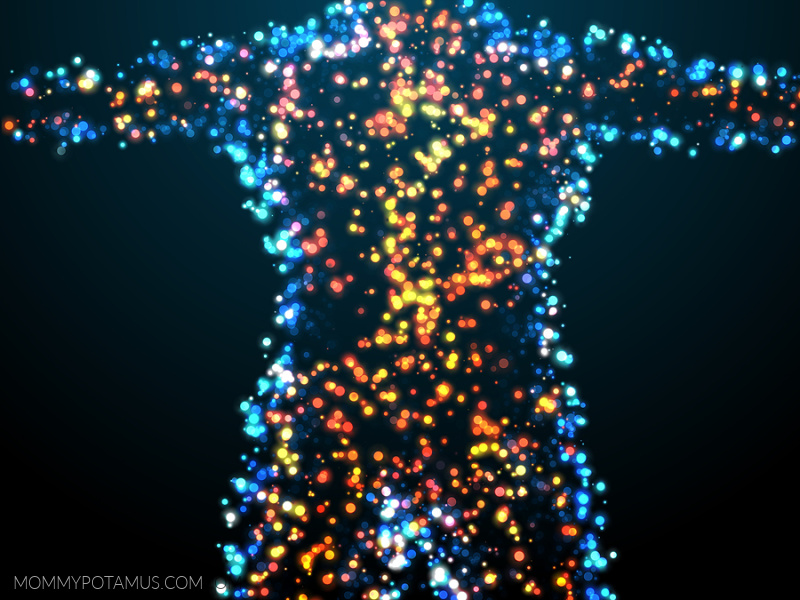
Lymphatic Flow & Detoxification ^
When most people hear the phrase “circulatory system,” they think of the heart, veins and arteries . . . but actually, our bodies have two circulatory systems.
Unlike the cardiovascular system which is powered by the heart, our lymphatic system is a passive circulatory system that relies on muscle contractions to “pump” immune cells throughout the body while removing pathogens, toxins, and abnormal cells (detoxification).
In the past, it was normal to walk five(ish) miles per day, which is enough to adequately stimulate the passive pump system. However, few of us actually do that these days, which may lead to poor lymph flow. Although I do take daily walks they’re definitely not five miles long, which is why a doctor-friend suggested I look into whole body vibration.
(If you missed it, I’m currently recovering from Lyme disease and although WBV is NOT a treatment, I do want my immune cells getting all the places in my body that they need to go, and detox is high on my priority list, too.)
Although there is little direct research on the benefits of vibration therapy for lymphatic drainage, this study notes that it is “very promising for skin blood microcirculation and lymphatic vessels stimulation.”
The researchers also mention another study (that unfortunately appears to be in French) which found that using vibration therapy after injecting a “tracer” substance under the skin of mice helped move the tracer compound into the lymph nodes in order to be cleared away.
Although more research is needed, many medical doctors and clinics recommend vibration therapy for individuals with impaired lymphatic function.
According to Dr. Thomas F. Wright, MD, FACPh, who specializes in the lymphatic system, “There have been multiple studies showing that vibration in the range of 10 to 30 Hertz it is likely the most effective for changing blood flow and indirectly lymphatic flow.” (5)
Hormone Production & Stress Relief ^
In studies like this one, participants who did whole body vibration and resistance-based exercise had higher testosterone and lower cortisol levels than participants who just did exercise.
In this study, healthy young men experienced a 7% increase in testosterone, a 27% decrease in cortisol (often called the stress hormone), and a 460% increase in growth hormone after doing a series of ten sessions (each one-minute long) on a vibration plate with rests in-between.
In another study done with young women who had a high BMI, an increase in growth hormone was also noted. (6)
Let’s take a look at what some of the hormones I just mentioned do:
- Testosterone – Has “powerful anti-aging effects. It turns fat into muscle, keeps skin supple, increases bone mineral density, gives us a positive mood, and boosts our ability to handle stress.” (1)
- Cortisol – Though it often gets a lot of negative attention as the “stress hormone,” cortisol can be beneficial when it motivates us to respond to a specific event, like a bear chasing us. Unfortunately, our bodies aren’t wired to tell the difference between serious emergencies (like a hungry bear) and the constant, low-grade stresses of everyday life like email, traffic, or a pile of dirty dishes in the sink when you’re feeling exhausted. These low level stresses can cause us to get stuck in stress mode, which directs our hormonal system to redirect nutrients toward making cortisol instead of the other hormones we need in order to feel relaxed, calm, vibrant, and focused.
- Growth Hormone – Helps build and repair healthy tissue in the brain and other organs, including our skin.
However, study results are mixed, and not all show a benefit. (7)
More research is needed to determine which frequencies and amplitudes work best for supporting hormone production, and what groups are most responsive to WBV.
Bone Mineral Density ^
We’ve already talked about the “Ironman of Spaceflight” Valery Polyakov’s results after spending longer in space than any other person, but I haven’t told you about the sheep yet.
About twenty years ago, researchers put 80’s-style wristbands on sheep and placed them on a vibrating platform for 20 minutes a day, five days a week. Okay, the wrisband part is not true, although honestly don’t you wish it was?
The rest of it is, though, and after a year the density of the spongy bone in the sheep’s thighs had increased by 34.2 percent. (8) Since then, researchers have tried to understand the effects of vibration therapy on the bone muscle density of athletes, postmenopausal women, and other groups.
In this study, “well-trained road cyclists” who received ten weeks of whole body vibration training had significantly more bone mineral density than the well-trained cyclists who didn’t receive WBV.
However, other study results are mixed. For example, this one done with postmenopausal women did not show benefits, while this meta-analysis did. In the latter study, researchers suggested that the optimal frequency for bone health was at least 20 Hz with an amplitude of at least 5 mm.
More research is needed to determine which frequencies and amplitudes work best for bone health, and what groups are most responsive to WBV.
Healthy Blood Flow ^
WBV increases blood flow in healthy people according to several studies, which is important because circulation “plays a vital role in tissue healing.”(9) (10) (11)
In addition to carrying the nutrients needed for repair and helping to remove waste, good blood flow also helps distribute white blood cells (needed for healthy immune function) throughout the body. (12)
Several studies have concluded that WBV is helpful for seniors, too. This one, for example, found that a vibrational frequency of 20 hertz (Hz) improved peripheral blood flow in active seniors and this one found improvement for sedentary seniors.
However, some types of vibration plates don’t appear to have an effect on blood flow. We’ll dive more into the different types of vibration plates later in this post, but for now what you need to know is that some move up-and-down, while others oscillate from side-to-side. There are also dual-motion or 3D motion machines that offer both types of movement.
In this study, researchers found that blood flow did increase when an oscillating platform was used, but not when a platform just moved up-and-down. They also noted lower frequencies (5-25 Hz) produced a greater effect than higher frequencies (30-50 Hz).
Collagen Production ^
Whole body vibration is also said to reduce the appearance of cellulite and help with skin smoothness by supporting collagen production. I haven’t seen any research on the effect of WBV on cellulite directly, but two studies did find that vibration therapy had a positive impact on collagen production and collagen gene expression. (13) (14) Both were animal studies, though, so more research is needed.
According to Drs. Bisson and Murad, cellulite is the result of decreased microcirculation, which affects blood flow (bringing nutrients to the area) and lymph fluid removal (taking waste away). The lack of nutrients and buildup of waste is said to cause connective tissue damage that leads to visible cellulite, so perhaps the ability of WBV to support microcirculation and lymph flow may be helpful.
However, the doctors also note that other factors also play a role in cellulite formation – such as diet and hormone balance.
Blood Sugar Support ^
In this study, researchers altered mice so that they had a leptin deficiency – which can lead to blood sugar control issues – and then they exposed them to WBV. Weirdly, one effect was that the population of a certain friendly gut bacteria (Alistipes) increased by 17-fold. (15)
Alistipes create short-chain fatty acids that help the body optimize its use of glucose.
Who should not use a vibration plate? ^
Whole body vibration is not for everyone. According to the manufacturer I purchased from, you should not use WBV if you have any of the following:
- Acute inflammations, infections and/ or fever
- Acute arthropathy or arthrosis
- Acute migraine
- Fresh (surgical) wounds
- Recent fractures (wait 6 weeks after a simple fracture, 12 weeks after a compound fracture or those repaired with implants)
- Implants of the spine
- Acute or chronic Deep Vein Thromboses or other thrombotic afflictions
- Acute disc related problems, Spondylosis, gliding Spondylolisthesis or fractures
- Severe osteoporosis with BMD < 70mg/ml
- Spasticity (after stroke/ spinal cord lesion)
- Morbus Sudeck Stadium I (CRPS I)
- Tumors with metastases in the musculoskeletal system
- Vertigo or positional dizziness
- Acute Myocardial Infarction
- Joint replacements (within 6 months of replacement surgery)
If you’re pregnant, suffer from chronic back pain, or have any of these conditions, you’ll want to talk to your doctor about whether whole body vibration would be a good supportive therapy or not.
Also, keep in mind that a recommended session time is about 10 minutes a day, and experts suggest working up slowly. Vibration therapy is powerful, and you should always follow your manufacturers usage guidelines.
Choosing A Vibration Plate ^
When you hear the word “exercise”, do you think of Crossfit? Yoga? Prancercising? (Probably not that last one, although it’s totally a thing.)
Though all are forms of exercise, they have different physiological effects. The same can be said for the different frequencies, amplitudes, and treatments times used in studies on vibration plates. There’s a huge range in what’s been tried, so it’s not surprising that some studies have found benefits, some found a neutral effect, and some even found negative effects. (More on that later.)
While researching vibration plates to use at home, I discovered that there are some pretty significant differences between them:
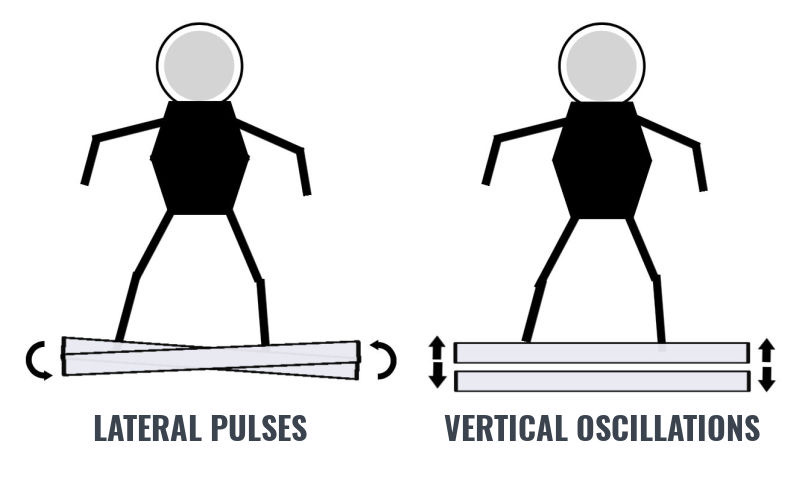
Types of Movement
Some vibration plates (often called linear, vertical or oscillating) move up-and-down, while others move from side-to-side like a seesaw (sometimes called lateral pulses). You’ll also find dual-motion or 3D motion machines that offer both types of movement, plus others.
Studies (and experts) are split on whether oscillating or pulsating movement is best, so I wanted one that could do both. However, I wanted to be able to do them separately because – at least according to one WBV advocate – doing them together could have a negative effect for some people. (Kind of like having two songs playing at once in a way that makes neither enjoyable.)
So far, I have tried all three types of movement (oscillating, pulsating, and combined) and felt good after each session.
Frequency Vs. Amplitude
If you imagine waves crashing on the shore, the number of waves per minute would be the frequency, and the size of the waves would be the amplitude. With vibration plates, the frequency is determined by the number of waves per second (measured in Hertz), and the amplitude is how much the vibration moves up-and-down (or side-to-side in a seesaw movement).
These two factors play a huge role in the effects of vibration therapy on the human body. The lymphatic system tends to resonate at lower frequencies, muscle tends to resonate slightly higher on the scale, and so on. However, extremely high vibrations, such as those emitted by some industrial equipment and/or power tools, can have negative effects.
Most of the studies I found that were looking for potential benefits did not go above 50 Hz, and 30 Hz was the most common.
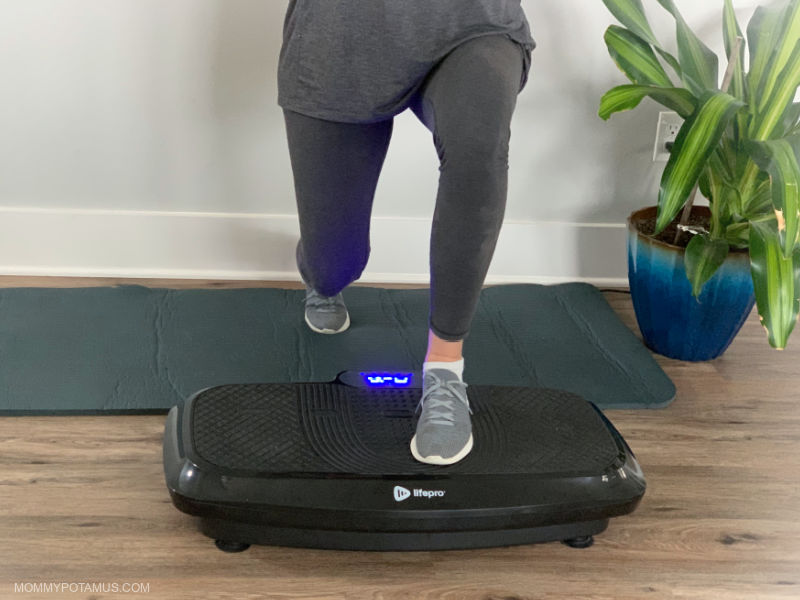
Which Vibration Plate I Chose (And Why) ^
Because research is ongoing about which frequencies and amplitudes work best for different goals, I knew I wanted a vibration plate that offered a range of options. I also wanted one that:
- Is portable (So I can exercise in different places and also put it away so that my home feels uncluttered)
- Doesn’t cost thousands of dollars
- Offered different movements that can be used separately
- Comes with pictures that demonstrate different workout positions
I ended up getting a Lifepro Vibration Plate. (SAVE $10 WITH CODE MP10) It met all of my criteria and also happens to be used and recommended by Dr. Terry Wahls, author of The Wahls Protocol.
Although her focus is on individuals with Multiple Sclerosis and other autoimmune disorders, her nutrition-based approach for supporting neurological health was something I found very helpful in the first part of my healing journey from Lyme.
My husband and I both LOVE our vibration plate. When I work out on it I feel recharged, and when I just stand on it I feel calm and relaxed.
There are several models available that you can compare here, but I want to highlight a few models:
Waver Vibration Plate
- Most affordable option
- One type of movement (vertical)
- Frequency range is 4-12 Hz and amplitude is 0-10 mm
- Designed to support metabolism, strength, circulation, toning, and lymphatic drainage
- Comes with remote control, resistance bands and mini bands
Find it here and use code MP10 for $10 off
Turbo 3D Vibration Plate (This is the one I bought)
- 3 types of movement (vertical, lateral pulses, and combined)
- Frequency range is 4-15 Hz and amplitude is 0-10 mm
- Designed to support metabolism, circulation, toning, lymphatic drainage, and a calm nervous system. According to the manufacturer, Level 1 also supports bone density
- Comes with remote control, resistance bands and mini bands
Find it here and use code MP10 for $10 off
Rumblex 4D Vibration Plate
- 7 types of movement (vertical, lateral, pulsating plus several different combinations of those three)
- Frequency range is 4-40 Hz and amplitude is 1-12 mm.
- Bluetooth enabled, which I consider a downside. However, it’s only intended to be used 10 minutes a day and it can be unplugged for the rest of the time, so I don’t think it’s a big deal.
- Designed to support metabolism, strength, circulation, toning, lymphatic drainage, bone density, core training, and balance training. Also helps calm the nervous system.
- Comes with remote that can be attached to the wrist if desired, resistance bands and mini bands, bluetooth speakers, a mat and lights
Find it here and use code MP10 for $10 off
Products Mentioned In This Article ^
Use code MP10 for $10 off.
Sources:
1. Chambers, Becky (2013) Whole Body VIbration: The Future of Good Health
2. Discover Magazine (2019) Whole Body Vibration: Does Shaking Up Our Workouts Lead to Better Health?
3. Aminian-Far, Atefeh et. al. (2011) Whole-Body Vibration and the Prevention and Treatment of Delayed-Onset Muscle Soreness
4. Cardinale, M and Wakeling, J (2005) Whole body vibration exercise: are vibrations good for you?
5. Wright, Thomas. Do Vibration Plates Help Lipedema?
6. Giunta, Marialuisa et. al. (2012) Growth hormone-releasing effects of whole body vibration alone or combined with squatting plus external load in severely obese female subjects
7. Di Loreto, C et. al. (2004) Effects of whole-body vibration exercise on the endocrine system of healthy men
8. Nature Journal of Science (2001) Sheep Shake A Leg & Strengthen Thighs
9. Lai, Chung-Liang (2014) Effect of whole-body vibration for 3 months on arterial stiffness in the middle-aged and elderly
10. Kerschan-Schindl, K et. al. (2001) Whole-body vibration exercise leads to alterations in muscle blood volume
11. Lythgo, Noel et. al. (2009) Whole-body vibration dosage alters leg blood flow
12. Dmitry A. Fedosov and Gerhard Gompper (2014) White blood cell margination in microcirculation
13. Dönmez, Gürhan et. al. (2016) Effects of immobilization and whole-body vibration on rat serum Type I collagen turnover
14. Thompson, William R. et. al. (2015) Low-Magnitude, High-Frequency Vibration Fails to Accelerate Ligament Healing but Stimulates Collagen Synthesis in the Achilles Tendon
15. Medical College of Georgia at Augusta University (2019) Whole body vibration shakes up microbiome, reducing inflammation in diabetes

